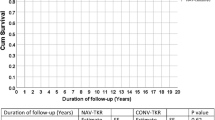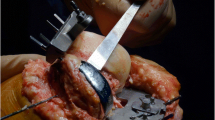Abstract
Purpose
The main objective was to analyze the computer-assisted navigation (CAN)-specific complications that forced to switch to conventional procedure in primary total knee replacement (TKR). The secondary objective was to determine the influence of those complications on TKR short-term survival.
Methods
Retrospective study of 878 primary TKR in 753 patients. Two consecutive versions of the OrthoPilot navigation system (Braun Aesculap, Germany) were used during the study time. Specific complications of CAN were defined as those due to the instrumentation (hardware or software failures), which were classified in one of two categories according to whether they occurred during the registration or tracking process.
Results
There were 20 (2.3%) complications related to the navigation system use that forced to switch to conventional surgery: in 11 (1.2%) knees due to loosening of the tracking pins, and in the other nine (1.0%) there were information system failures. There was a trend for a higher conversion rate to conventional surgery with the use of the first version of the software. There were no fractures, infections, or nerve injuries at the pin site. We found no differences in the distribution of baseline variables among those with or without conversion to conventional surgery. There was no significant difference (p = 0.488) in the two year survival between patients with or without conversion.
Conclusion
CAN for primary TKR is a safe method with few specific complications that forced to switch from the navigated to the conventional procedure. Conversion to conventional surgery did not affect the short-term survival of TKR.

Similar content being viewed by others
References
Boylan M, Suchman K, Vigdorchik J, Slover J, Bosco J (2018) Technology-assisted hip and knee arthroplasties: an analysis of utilization trends. J Arthroplast 33:1019–1023. https://doi.org/10.1016/j.arth.2017.11.033
Buza JA 3rd, Wasterlain AS, Thakkar SC, Meere P, Vigdorchik J (2017) Navigation and robotics in knee arthroplasty. JBJS Rev 5: 01874474-201702000-00001. doi: https://doi.org/10.2106/JBJS.RVW.16.00047
Cip J, Obwegeser F, Benesch T, Bach C, Ruckenstuhl P, Martin (2018) A.twelve-year follow-up of navigated computer-assisted versus conventional total knee arthroplasty: a prospective randomized comparative trial. J Arthroplast 33:1404–1411. https://doi.org/10.1016/j.arth.2017.12.012
Panjwani TR, Mullaji A, Doshi K, Thakur H (2019) Comparison of functional outcomes of computer-assisted vs conventional total knee arthroplasty: a systematic review and meta-analysis of high-quality, prospective studies. J Arthroplast 34:586–593. https://doi.org/10.1016/j.arth.2018.11.028
Hernandez-Vaquero D, Suarez-Vazquez A (2007) Complications of fixed infrared emitters in computer assisted total knee arthroplasties. BMC Musculoskelet Disord 8:71. https://doi.org/10.1186/1471-2474-8-71
Beldame J, Boisrenoult P, Beaufils P (2010) Pin track induced fractures around computer-assisted TKA. Orthop Traumatol Surg Res 96:249–255. https://doi.org/10.1016/j.otsr.2009.12.005
Brown MJ, Matthews JR, Bayers-Thering MT, Phillips MJ, Krackow KA (2017) Low incidence of postoperative complications with navigated total knee arthroplasty. J Arthroplast 32:2120–2126. https://doi.org/10.1016/j.arth.2017.01.045
Kamara E, Berliner ZP, Hepinstall MS, Cooper HJ (2017) Pin site complications associated with computer-assisted navigation in hip and knee arthroplasty. J Arthroplast 32(9):2842–2846. https://doi.org/10.1016/j.arth.2017.03.073
Owens RF Jr, Swank ML (2010) Low incidence of postoperative complications due to pin placement in computer-navigated total knee arthroplasty. J Arthroplast 25:1096–1098. https://doi.org/10.1016/j.arth.2009.07.025
Thomas A, Pemmaraju G, Nagra G, Bassett J, Deshpande S (2015) Complications resulting from tracker pin-sites in computer navigated knee replacement surgery. Acta Orthop Belg 81:708–712
Khakha RS, Chowdhry M, Norris M, Kheiran A, Chauhan SK (2015) Low incidence of complications in computer assisted total knee arthroplasty: a retrospective review of 1596 cases. Knee 22:416–418. https://doi.org/10.1016/j.knee.2015.02.009
Gholson JJ, Duchman KR, Otero JE, Pugely AJ, Gao Y, Callaghan JJ (2017) Computer navigated total knee arthroplasty: rates of adoption and early complications. J Arthroplast 32:2113–2119. https://doi.org/10.1016/j.arth.2017.01.034
Dyrhovden GS, Fenstad AM, Furnes O, Gøthesen Ø (2016) Survivorship and relative risk of revision in computer-navigated versus conventional total knee replacement at 8-year follow-up. Acta Orthop 87:592–599. https://doi.org/10.1080/17453674.2016.1244884
d’Amato M, Ensini A, Leardini A, Barbadoro P, Illuminati A, Belvedere C (2019) Conventional versus computer-assisted surgery in total knee arthroplasty: comparison at ten years follow-up. Int Orthop 43:1355–1363. https://doi.org/10.1007/s00264-018-4114-5
Sciberras NC, Almustafa M, Smith BRK, Allen DJ, Picard F, Deakin AH (2016) A randomized controlled trial to compare component placement in navigated total knee arthroplasty using original and streamlined registration processes. Arthroplasty Today 3:111–117. https://doi.org/10.1016/j.artd.2016.07.002
Jenny JY, Miehlke RK, Giurea A (2008) Learning curve in navigated total knee replacement. A multi-centre study comparing experienced and beginner centres. Knee 15:80–84. https://doi.org/10.1016/j.knee.2007.12.004
Jones CW, Jerabek SA (2018) Current role of computer navigation in total knee arthroplasty. J Arthroplast 33:1989–1993. https://doi.org/10.1016/j.arth.2018.01.02
Ouanezar H, Franck F, Jacquel A, Pibarot V, Wegrzyn J (2016) Does computer-assisted surgery influence survivorship of cementless total knee arthroplasty in patients with primary osteoarthritis? A 10-year follow-up study. Knee Surg Sports Traumatol Arthrosc 24:3448–3456. https://doi.org/10.1007/s00167-016-4112-3
Manzotti A, Confalonieri N, Pullen C (2008) Intra-operative tibial fracture during computer assisted total knee replacement: a case report. Knee Surg Sports Traumatol Arthrosc 16:493–496. https://doi.org/10.1007/s00167-008-0485-2
Massai F, Conteduca F, Vadala A, Iorio R, Basiglini L, Ferretti A (2010) Tibial stress fracture after computer-navigated total knee arthroplasty. J Orthop Traumatol 11:123–127. https://doi.org/10.1007/s10195-010-0096-9
Hoke D, Jafari SM, Orozco F, Ong A (2011) Tibial shaft stress fractures resulting from placement of navigation tracker pins. J Arthroplast 26:504.e5–504.e8. https://doi.org/10.1016/j.arth.2010.05.009
Jung KA, Lee SC, Ahn NK, Song MB, Nam CH, Shon OJ (2011) Delayed femoral fracture through a tracker pin site after navigated total knee arthroplasty. J Arthroplast 26:505.e9–505.11. https://doi.org/10.1016/j.arth.2010.01.006
Bonutti P, Dethmers D, Stiehl JB (2008) Case report: femoral shaft fracture resulting from femoral tracker placement in navigated TKA. Clin Orthop Relat Res 466:1499–1502. https://doi.org/10.1007/s11999-008-0150-6
Edgerton BC, An KN, Morrey BF (1990) Torsional strength reduction due to cortical defects in bone. J Orthop Res 8:851–855. https://doi.org/10.1002/jor.1100080610
Kuo RF (1991) The effect of defect size on the stress concentration and fracture characteristics for a tubular torsional model with transverse hole. J Biomech 24:147–155. https://doi.org/10.1016/0021-9290(91)90359-u
Berning ET, Fowler RM (2011) Thermal damage and tracker-pin track infection in computer-navigated total knee arthroplasty. J Arthroplast 26:977.e21–977.e24. https://doi.org/10.1016/j.arth.2010.08.012
Author information
Authors and Affiliations
Corresponding author
Ethics declarations
Conflict of interest
The authors declare have no conflict of interest.
Ethical approval
All procedures performed in studies involving human participants were in accordance with the ethical standards of the institutional and/or national research committee and with the 1964 Helsinki declaration and its later amendments or comparable ethical standards.
Informed consent
Informed consent was not required by the institutional review board.
Additional information
Publisher’s note
Springer Nature remains neutral with regard to jurisdictional claims in published maps and institutional affiliations.
Rights and permissions
About this article
Cite this article
Novoa-Parra, C.D., Sanjuan-Cerveró, R., Franco-Ferrando, N. et al. Complications of computer-assisted navigation in total knee replacement: retrospective cohort of eight hundred and seventy eight consecutive knees. International Orthopaedics (SICOT) 44, 2621–2626 (2020). https://doi.org/10.1007/s00264-020-04675-x
Received:
Accepted:
Published:
Issue Date:
DOI: https://doi.org/10.1007/s00264-020-04675-x




